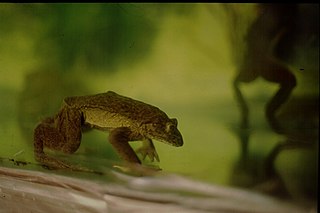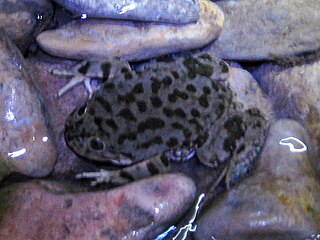
Telmatobius is a genus of frogs native to the Andean highlands in South America, where they are found in Ecuador, Peru, Bolivia, northwestern Argentina and northern Chile. It is the only genus in the family Telmatobiidae. Some sources recognize Batrachophrynus as a valid genus distinct from Telmatobius.
Telmatobius brachydactylus, the Amable Maria frog, is an endangered species of frog in the family Telmatobiidae.

Telmatobius macrostomus, also known as the Lake Junin (giant) frog or Andes smooth frog, is a very large and endangered species of frog in the family Telmatobiidae. This completely aquatic frog is endemic to lakes and associated waters at altitudes of 4,000–4,600 m (13,100–15,100 ft) in the Andes of Junín and Pasco in central Peru. It has been introduced to slow-moving parts of the upper Mantaro River, although it is unclear if this population still persists.
Telmatobius arequipensis is a species of frog in the family Telmatobiidae. It is endemic to southern Peru. It has an altitudinal range of 2,000–4,500 m (6,600–14,800 ft) asl. Two subspecies have been described, Telmatobius arequipensis arequipensis and Telmatobius arequipensis natatorVellard, 1955. Its common name is Chili water frog, after its type locality near Río Chili.
Telmatobius bolivianus is a species of frog in the family Telmatobiidae. It is endemic to the Eastern Andes of Bolivia. It was formerly the most common and widespread Telmatobius of Bolivia, but has had a drastic population decline since the mid-2000s. It is an aquatic frog occurring in fast-flowing rivers and streams in cloud forest and Yungas forest. It is threatened by chytridomycosis as well as habitat loss caused by logging and agricultural expansion. Water pollution and aquaculture are also threats.
Telmatobius colanensis is a species of frog in the family Telmatobiidae. It is endemic to northern Peru and only known from its type locality on the Cordillera Colán, near La Peca, Amazonas Region.
Telmatobius dankoi, also known as the Loa water frog, is a species of critically endangered aquatic frog in the family Telmatobiidae. It is endemic to Chile and is only known from its type locality near Calama, in the El Loa province. Only 14 individuals are known from captivity following the destruction of its habitat prior to 2019, so it may already be extinct in the wild. However, it is doubtfully distinct from Telmatobius halli and thus may not be a distinct species.
Telmatobius degener is a species of frog in the family Telmatobiidae. It is endemic to the La Libertad Region of Peru and only known from its type locality between Otuzco and Huamachuco, at 3,290 m (10,790 ft) asl. The type locality is in the very humid subalpine páramo. The frogs were active by day and found in pools and running water in a densely vegetated roadside marsh in an open pasture.
Telmatobius halli is a species of frog in the family Telmatobiidae. It is endemic to northern Chile and only known from its type locality near Ollagüe. The specific name halli honors Frank Gregory Hall, an American specialist on the effects of high altitudes on human body and collector of the type series. Its common name is Hall's water frog.
Telmatobius ignavus is a species of frog in the family Telmatobiidae. It is endemic to the Cordillera de Huancabamba in the Department of Piura, Peru. Common name Piura water frog has been coined for it.
Telmatobius jelskii, also known as the Acancocha water frog, is a near-threatened species of frog in the family Telmatobiidae, endemic to the Andes of central Peru. This semiaquatic frog is found in and near streams and ditches at altitudes of 2,700–4,500 m (8,900–14,800 ft). It breeds in streams.

Telmatobius marmoratus, the marbled water frog, is a vulnerable species of frog in the family Telmatobiidae. The most widespread species in the genus, it is found in the Andean highlands of Bolivia, northern Chile and southern Peru. It may also occur in northwestern Argentina, but the taxonomic position of this population is unclear. This semiaquatic frog is found in and near streams, rivers, waterfalls, lakes and ponds.
Telmatobius pefauri is a species of frog in the family Telmatobiidae. It is endemic to extreme northern Chile. It was already feared that this species is extinct, but recent research has suggested that the species is extant at several localities in the Arica y Parinacota Region, albeit at low numbers. Furthermore, morphological and genetic data suggest that Telmatobius zapahuirensis is a synonym of Telmatobius pefauri. Common name Arico water frog has been coined for this species.
Telmatobius vilamensis is a species of frog in the family Telmatobiidae. It is endemic to northern Chile and only known from its type locality, Río Vilama near San Pedro de Atacama. The specific name vilamensis refers to the type locality. It may already be extinct, although it is doubtfully distinct from Telmatobius halli.
The Sehuencas water frog is a species of frog in the family Telmatobiidae. It is endemic to Bolivia. Its natural habitats are subtropical or tropical moist montane forest, rivers, and freshwater marshes. It is threatened by habitat loss. No individuals were encountered in the wild between 2008 and 2019.

Telmatobius culeus, commonly known as the Titicaca water frog or Lake Titicaca frog, is a medium-large to very large and endangered species of frog in the family Telmatobiidae. It is entirely aquatic and only found in the Lake Titicaca basin, including rivers that flow into it and smaller connected lakes like Arapa, Lagunillas and Saracocha, in the Andean highlands of Bolivia and Peru. In reference to its excessive amounts of skin, it has jokingly been referred to as the Titicaca scrotum (water) frog.
Telmatobius espadai, also known as the Inquisivi water frog, is a species of frogs in the family Telmatobiidae, one of fourteen species of Telmatobius water frogs endemic to Bolivia.
Telmatobius mendelsoni is a species of frog in the family Telmatobiidae. It was last seen in 1984 and is believed to be possibly extinct.





